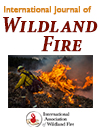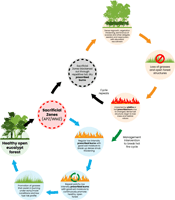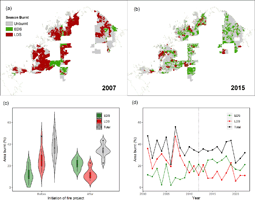International Journal of Wildland Fire
Volume 33
Number 9 2024
Predicted fire behaviour varies significantly when cross-landscape fuel moisture differences are included in simulations. In temperate fuels, where live fuel moisture is not well represented in models, this may create dangerous situations where fire behaviour is underpredicted during the typical spring fire season, which has implications for fire management decision-making.
Case studies explore the impact of fire regimes on vegetation structure and fuel risk in Southeast Queensland, Australia. High intensity wildfires and asset protection burns can promote excessive shrub and sapling densities, increasing elevated fuel loads. We recommend burns are done under moist, mild conditions to maintain an open forest structure and minimise fire hazard.
This article belongs to the Collection Fire and Climate.
Fourier Transform Infrared (FTIR) spectroscopy was applied to sediment deposits in southeastern Australia. The aromatic/aliphatic ratio was used as a proxy for high-intensity fires. The increased frequency of high-intensity fire events could result from interactions between climate, people, and vegetation. The existing fire record was extended by centuries to millennia.
Nitrogen, a critical nutrient for life, can also become a pollutant when flushed to streams after fire. We assessed how burn severity interacts with soil moisture to influence how recovering ecosystems take up nitrogen. When fire is severe or dry conditions follow fire, ecosystems take up less nitrogen.
This study uses detailed wildfire observation data to describe non-steady headfire rate of spread and the effect of barriers to fire propagation, such as roads, on halting or inhibiting spread. We discuss the implications for wildfire spread modelling and fireline safety.
Our study used satellite imagery to examine wildfire patterns before and after the North Kimberley Fire Abatement Project, an indigenous fire project, was established in northern Western Australia. We show that damaging wildfires were effectively reduced and discuss the reasons for this success.
This article belongs to the Collection Savanna Burning.
This review identifies current health risk communications for prescribed burn smoke exposure in the United States. While this review highlights several effective communication strategies, further research is needed to better understand prevention and intervention approaches and the efficacy of communication strategies to minimise health risks of prescribed burns.
Knowledge of how past fires may influence the future flammability of ecosystems remains poorly resolved. Here, we report significant effects of past fire frequency on the chemical properties of canopy leaves and leaf litter in a coastal Eucalyptus forest, which may have important implications for future forest flammability.
We use machine learning to predict the probability an area is suitable for a wildland firefighter lookout based on incident data, roads, and lidar-derived visibility, terrain, and vegetation information. This approach may aid pre-fire planning and enhance situational awareness by providing maps of potential lookout locations.
Composition of pyrolysis gases measured in non-oxidising and ambient atmospheric conditions has been compared using compositional data analysis. Mean compositions changed between the non-oxidising and ambient atmosphere samples. These results indicate the need for more fundamental research on the early time-dependent pyrolysis of vegetation in the presence of oxygen.
Post-fire debris flows are increasing in the western United States, where they further threaten declining surface water supplies. We modelled fire behaviour and post-fire debris flows to understand debris-flow likelihood and volume, as well the influences of fuel reduction treatments, in the Santa Fe Municipal Watershed, New Mexico.







